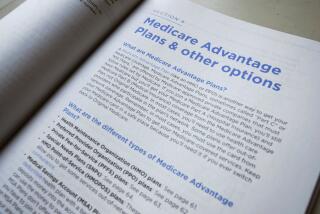Imagining U.S. seniors in a world without Medicare
It’s pretty well known that Americans pay more for health insurance and medical treatment than people in other developed countries — at least until they turn 65 and are eligible for Medicare.
But what would things look like if the government-run insurance plan wasn’t an option?
Kaiser Permanente provided a glimpse of such a prospect when it notified Chatsworth resident Layne Smith recently that his monthly insurance premium would double on Jan. 1 to $1,816.65 from $904.54.
Why? Because of “a standard yearly rate change based on your age.”
Smith turned 65 on Monday.
Happily, he did enroll in Medicare, so he won’t have to pay $1,800 a month for health insurance.
Socorro Serrano, a Kaiser spokeswoman, said the health maintenance organization sent out the rate-hike notice before it realized that Smith’s Medicare coverage would begin Sept. 1.
Even so, she said, Kaiser can’t assume that everyone turning 65 will sign up for Medicare or its more comprehensive cousin, Medicare Advantage.
“Of the more than 1 million members over 65 that we cover in California, a very small number — about 500 — have opted to stay in their pre-2010 plan,” Serrano said.
Maybe they just love their current plans. Or maybe they’re among the relatively few Americans who don’t qualify for Medicare Part A, which covers hospital stays, because they or their spouse haven’t contributed a portion of paychecks into the system for at least 10 years.
To be sure, older people run up more healthcare costs on average than younger people, so insurers are playing the odds.
“Rate changes are often bundled into five-year ‘age bands,’ meaning as people hit a birthday ending in 0 or 5 they may see a noticeable rate change,” Serrano said.
But relying primarily on age rather than a person’s physical condition when determining the cost of health insurance is like selling coverage to a driver without taking into account his or her road-safety record. Some people are simply higher risks than others.
Smith, who is retired, told me that he hasn’t had a significant health problem over the last 12 months and hasn’t submitted any claims for medical treatment other than for a prescription drug he’s been taking for years.
“I feel fine,” he said. “I walk my dogs. I do whatever I want. There’s nothing wrong.”
I shared Smith’s Kaiser notice with Steve Valentine, president of the Camden Group, a Los Angeles healthcare consulting firm. He said it looked as if Kaiser would arbitrarily charge all 65-year-olds more than $1,800 a month if it could get away with it.
“This doesn’t surprise me at all,” Valentine said. “When you’re that age, I would expect them to charge that kind of money.”
Even though Smith is in generally good health? Yup, Valentine replied.
“The healthy subsidize the sick,” he said. “Otherwise the sick would be so expensive, they’d be impossible to insure.”
In a perfect world, premiums paid by younger, healthier people would offset claims by older, sicker people, and it would all balance out, more or less. This is how insurance works in nearly all other developed countries.
In the United States, home of for-profit healthcare, we manage medical risk as expensively and inefficiently as we can by dividing people into clusters of sick and healthy.
“The private insurers have captured the healthiest portion of the population,” said Gerald Kominski, director of the UCLA Center for Health Policy Research. “Public programs such as Medicare and Medicaid target those portions of the population that the private sector doesn’t want — poor people and the elderly.”
The solution is clear, he said: Expand Medicare eligibility to everyone, young and old, and spread healthcare risk more evenly throughout society. The addition of millions of young and healthy people into the system would solve the program’s financial woes overnight, Kominski said.
Critics of a national insurance program need only look at Kaiser’s notice to Smith, which experts say is indicative of the sort of rate hikes all seniors would experience in a non-Medicare world, whether they were in an HMO or a preferred provider organization insurance plan.
“A Medicare-for-all system would solve that,” Kominski said.
The monthly premium for Medicare Part B, which covers doctors visits, is unchanged this year at $104.90, with an annual deductible of $147. Medicare Part D, which covers prescription drugs, costs an average $32 a month.
Anyone age 65 or older who is ineligible for Medicare, or who would rather not participate in the system for whatever reason, should turn immediately to the state exchanges created under the Affordable Care Act.
Although age is still used in setting rates, insurers participating in the exchanges are prevented by law from charging someone in their 60s more than three times what they charge someone in their 20s.
Under Obamacare, the average 30-year-old pays $284 a month for a mid-range Silver plan, the average 40-year-old $319, the average 50-year-old $447 and the average 60-year-old $678, according to the coverage-comparison site HealthPocket.com.
That’s what an efficient, well-regulated health insurance market looks like.
Rather than letting private insurers charge whatever they please.
David Lazarus’ column runs Tuesdays and Fridays. He also can be seen daily on KTLA-TV Channel 5 and followed on Twitter @Davidlaz. Send your tips or feedback to david.lazarus@latimes.com.







